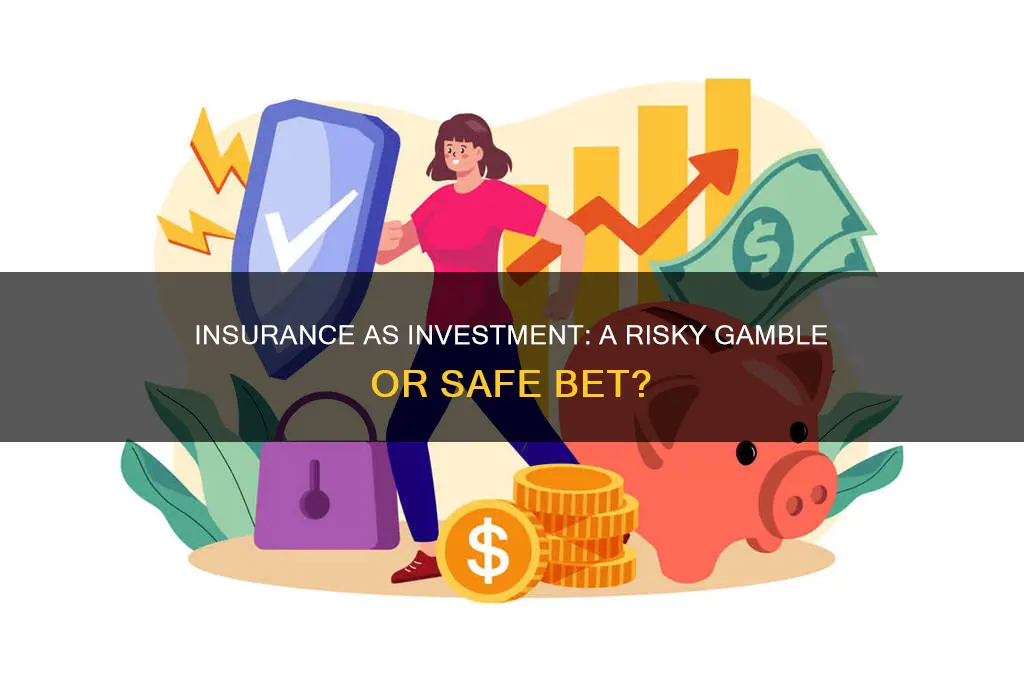
Life insurance is a simple concept: you pay a premium, and your beneficiaries receive a sum of money when you die. However, whole life insurance—a type of permanent life insurance—also features a cash value component, which is where things get complex. While whole life insurance can be a good investment for some, it's not suitable for most people due to high costs and low returns.
Whole life insurance provides permanent coverage and accumulates a cash value over time. When you pay your premium, a portion is invested by the insurer to give your policy a cash value, which grows at a fixed, guaranteed rate in a tax-advantaged account. You can borrow against or withdraw this cash value, but any outstanding loans will be subtracted from the payout upon your death. Whole life insurance also tends to have much higher premiums than term life insurance. For example, a healthy 40-year-old man can expect to pay an average annual premium of $4,471 for a $500,000 whole life insurance policy, compared to $340 for a term life policy.
Whole life insurance may be a good investment for high-net-worth individuals who have maxed out their tax-advantaged accounts, those with lifelong financial dependents, and those who want to help their family pay estate taxes. However, for most people, the low and slow-growing rate of return, lack of control over the portfolio, and potential tax implications upon withdrawal make whole life insurance a poor investment choice.
| Characteristics | Values |
|---|---|
| Cost | Whole life insurance is much more expensive than term life insurance. |
| Returns | The average annual rate of return on the cash value for whole life insurance is 1% to 3.5%. |
| Risk | Whole life insurance offers fixed, guaranteed returns on your cash value. |
| Tax advantages | Whole life insurance offers tax-deferred savings. |
| Peace of mind | Whole life insurance can offer peace of mind to anyone with financial dependents. |
| Flexibility | Whole life insurance is not a good option for those who only need life insurance for a specific length of time. |
| Control | Whole life insurance offers a fixed rate of return on cash value, with no investment choices. |
| Liquidity | It can take 10 to 15 years (or even longer) for you to build up enough cash value to borrow against. |
What You'll Learn

High fees and low returns
Permanent life insurance policies generally carry higher premiums than term life insurance policies. For example, a healthy 40-year-old man can expect to pay an average annual premium of $4,471 for a $500,000 whole life insurance policy, while a woman of the same age might pay $4,123. In comparison, a term life policy for a healthy 40-year-old would cost $340 for a man and $288 for a woman, on average.
The high fees associated with permanent life insurance policies can be attributed to various factors, including the cost of insurance protection itself, marketing and sales commissions, and a "surrender charge" that may be levied if the policy is dropped within the first 10 years or so. These charges can often exceed the total amount of the first year's premium. Additionally, there are annual investment fees that are not always disclosed and can be substantial, further adding to the overall cost.
In terms of returns, permanent life insurance policies typically offer low rates of return, which can be as low as 1% to 3.5% on average. While these returns are guaranteed and tax-deferred, they may not be sufficient for individuals seeking higher returns or looking to maximize their investments. The low returns can be partly due to the slow growth of the cash value component in these policies. It can take 10 to 15 years or even longer for the cash value to accumulate enough to borrow against, which may not align with the investment goals of some individuals.
Overall, the high fees and low returns associated with permanent life insurance policies can be significant drawbacks for individuals considering them as an investment option. The high costs can eat into potential returns, and the low rates of return may not meet the expectations of those seeking higher investment gains. Therefore, it is essential to carefully consider the financial goals, risk tolerance, and investment horizon before deciding whether permanent life insurance is the right choice.
Robinhood: Still Relevant?
You may want to see also

Whole life insurance is expensive
Whole life insurance is designed to provide coverage for the insured's entire life, and its premiums remain fixed throughout the policyholder's life. This type of insurance also includes a cash value component, which grows over time and can be borrowed against or withdrawn. The cash value accumulates on a tax-deferred basis, and the policy may pay dividends, providing additional growth opportunities. These features make whole life insurance a valuable tool for long-term financial and estate planning.
However, the high cost of whole life insurance is a significant disadvantage. The premiums are typically higher than those of term life insurance, making it one of the most expensive types of life insurance. The cost includes the insurance protection, marketing and sales commissions, and potentially a "surrender charge" if the policy is dropped within the first few years. Additionally, there may be annual investment fees, including an investment management fee and a "mortality and expense" charge. These fees can amount to 3% or more of the policy's value each year, which is significantly higher than the expenses associated with mutual funds.
While whole life insurance offers comprehensive benefits, fixed premiums, and cash value growth, it may not be the best option for everyone. For younger individuals who are not high earners, the high premiums may not be justifiable. It is important to consider one's financial situation, goals, and other available investment options before deciding to purchase whole life insurance.
Kroenke's Arsenal: A New Dawn or False Hope?
You may want to see also

Cash value is slow to grow
When you pay your insurance premiums, only a small portion goes into the cash value account. The insurance company takes a cut for expenses and profit, and the rest is invested. This means that the cash value of your policy will grow slowly, often at a rate that is lower than other investment options. The growth of your cash value is also dependent on the insurance company's investment performance, which can be unpredictable and vary widely between companies. This slow growth can be a significant disadvantage, especially when compared to other investment options that may provide higher returns over time.
Whole life insurance policies are often sold as investment vehicles, with agents emphasizing the cash value component. They may tout the ability to borrow against the policy or even surrender it for a lump sum. However, the reality is that these policies can be extremely slow to accumulate any significant cash value. The first few years of premium payments often go almost entirely towards covering the cost of insurance and the insurance company's expenses and profit. It can take a decade or more for the cash value to grow to a point where it exceeds the total premiums paid.
In contrast, investing the same amount in a simple index fund or diversified portfolio of stocks and bonds would likely result in significantly higher returns over time. Even conservative investment strategies that focus on income generation through dividends and interest would likely outperform the cash value growth of an insurance policy. This is because the fees and expenses associated with insurance policies are often much higher than those of traditional investment vehicles, eating into potential returns.
Additionally, the growth of the cash value is often taxable upon withdrawal, further reducing the overall returns. While there are some tax advantages to the cash value growth within the policy, these are often outweighed by the slow growth rate and high fees. It's important to remember that insurance should be treated as a form of risk management, not as a primary investment vehicle. There are far more efficient and effective ways to grow your wealth over the long term.
To summarize, while permanent life insurance policies offer a cash value component, it is important to recognize that this value grows slowly and may not provide the investment returns you expect. The fees and expenses associated with these policies can be high, and there are often more efficient and profitable ways to invest your money. Treating insurance as a form of risk management, rather than an investment, is generally a more prudent approach to personal finance. It is always a good idea to consult with a qualified financial advisor to determine the best strategies for your specific situation.
Real Estate: Why the Hesitation?
You may want to see also

Tax implications of withdrawing cash
Withdrawing cash from a permanent life insurance policy can have tax implications, depending on the amount withdrawn and the type of policy. It's important to consult a tax advisor or insurance professional to fully understand the tax consequences before making any withdrawals.
In general, withdrawals from a permanent life insurance policy are tax-free up to the total amount of premiums paid. This means that if you withdraw an amount equal to or less than the total premiums you have paid, you will not owe any taxes on that amount. However, if you withdraw more than the total premiums paid, the excess amount may be subject to income tax.
It's important to note that there are different types of permanent life insurance policies, such as universal and traditional whole life policies, and not all policies allow withdrawals. Additionally, some policies may have surrender charges or other fees associated with withdrawals, even if the withdrawal is within the total premiums paid.
Withdrawing cash from a permanent life insurance policy can also affect the death benefit and the coverage provided by the policy. Withdrawing more than the total premiums paid may result in a reduction of the death benefit, and if there is not enough cash value left in the policy, the coverage may lapse.
Another option for accessing cash from a permanent life insurance policy is to take out a policy loan, using the cash value as collateral. Policy loans may have lower interest rates than personal loans, and they do not require a separate approval process. However, if the loan is not repaid before the policyholder's death, it could reduce the death benefit or even cause the policy to lapse.
It's important to carefully consider the tax and financial implications of withdrawing cash from a permanent life insurance policy before making any decisions. Consulting a financial advisor or tax expert can help individuals make informed choices about their life insurance policies and ensure they understand the potential tax consequences of any withdrawals.
Global Investing: Why Go International?
You may want to see also

Better options for investment and insurance
When considering adding life insurance to your financial plan, it's important to determine if the potential for paying premiums for years is worth it. Whether life insurance is a smart investment depends on what you want a policy to do for you. If you want to give a measure of financial security to your loved ones in case of your death, then term life insurance is probably worth it. However, if you're looking for tax-free investment benefits while you're alive, most people would be better off getting a term policy and putting the rest of their money in other types of tax-free investments.
- High-yield savings accounts: These accounts pay interest on your cash balance and are a good vehicle for those who need to access cash in the near future.
- Long-term certificates of deposit (CDs): CDs are issued by banks and generally offer a higher interest rate than savings accounts. They can be a good choice for retirees who don't need immediate income and can lock up their money for a longer period.
- Long-term corporate bond funds: Corporations sometimes raise money by issuing bonds to investors, and these can be packaged into bond funds. They can be an excellent choice for investors looking for cash flow or those who want to reduce their overall portfolio risk but still earn a return.
- Dividend stock funds: Dividends are portions of a company's profit that are paid out to shareholders. Dividend stock funds are a good selection for almost any kind of stock investor but can be better for those who are looking for income.
- Value stock funds: These funds invest in value stocks, which are more bargain-priced than others in the market. They tend to do better as interest rates rise and growth stocks become less attractive.
- Small-cap stock funds: These funds invest in stocks of relatively small companies, which often have strong growth prospects. A diversified small-cap fund helps to even out the risks.
In addition to these investment options, there are also alternative insurance options to consider:
- Term life insurance: Term life insurance can make sense if you want to be covered for a set period, during which your beneficiaries will receive money to help replace your income if you die. It is generally less expensive than permanent life insurance.
- Permanent life insurance: This type of insurance covers you for life as long as your premiums are paid. It includes a cash value component that grows tax-free and can be borrowed against or withdrawn. However, permanent life insurance generally carries higher premiums and may not be the right choice for everyone.
Understanding the Rule of 72: Unlocking the Power of Compounding
You may want to see also







